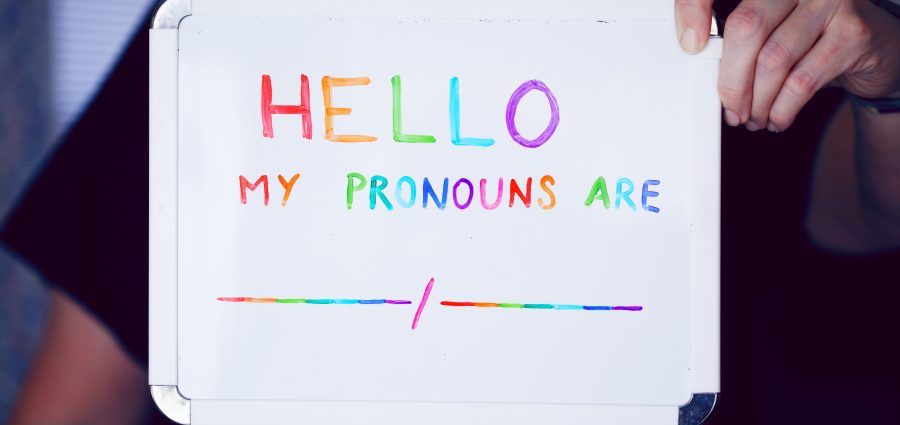As increasingly more people come forward as transgender, non-binary, gender neutral or gender fluid, gender identity has become a hot topic in recent years. Do you refer to someone as “she/her”, “he/her” or “they/them”? More importantly, do you include your own pronouns in job applications? Job-hunting can be daunting enough without having to deal with such issues as well.
If you have never had to worry about your gender identity, this topic might not be so important. However, for people who are constantly misgendered based on their name or appearance, the experience can leave them feeling marginalised or excluded. By using your pronouns in your job applications, you can help make pronouns part of the conversation and show your support for the global movement of inclusion and diversity.
But where can you mention your preferred pronouns? In this article, we will show you 6 ways to convey your gender pronouns in job applications. For a clear, structured CV format to help you organise your information, consider using a CV builder.
Include your preferred pronouns in your CV
The simplest way to share your preferred pronouns with recruiters and hiring managers is to add them to your CV, in the header, under your name and below your contact information. If you want to make them stand out, you could also choose to put them in a different colour.
Alternatively, if you prefer to include your pronouns more discreetly in your CV, you can put them in a smaller font. Whichever option you choose, sharing your pronouns from the onset can easy any anxiety you may feel about potentially having to clarify your gender identity in interviews.
Update LinkedIn with your preferred pronouns
Another easy way to convey your preferred pronouns is by updating your LinkedIn profile. Even if your LinkedIn profile contains a photo, there’s still the possibility that recruiters will not accurately interpret your gender, based on your appearance or your name, if it happens to be uncommon.
By personalising your LinkedIn profile with your pronouns, you can let others know how to address you properly, avoid potential misunderstandings and make help create a safe environment for everyone else to share theirs.
To add your pronouns to your LinkedIn profile, simply go to “View Profile” and click on the pencil icon.
Indicate your preferred pronouns on job application forms
When it comes to online job applications, more companies are starting to add general-neutral options to their application forms, to let know candidates know that they are inclusive and do not discriminate. In such cases, you will usually have the option to indicate your preferences by selecting “M”, “Y” or “X”.
If you feel that this information is too sensitive or want to share it at a later stage, you can choose to select “Other” or “Prefer not to say”. If neither of those options are available, you can always select both the male and female gender options in the application form and clarify your preferences later.
Sign your cover letter with your preferred pronouns
If you do not have the option to indicate your gender in the application form, you can do so in your cover letter by adding your preferred pronouns just under your name or in the e-mail in which you send your application. These can go either beside your name or below your signature.
This can be a discreet way of letting recruiters how you want to be addressed, while not drawing attention to your gender, and can be especially helpful if you have a gender-neutral name such as Charlie to Alex.
In turn, you can address your cover letter correctly and avoid offence, by looking up the hiring manager’s pronouns on LinkedIn or on their company website. Alternatively, you can use their full name in your greeting without a title that reveals their gender.
Ask references to refer to you with preferred pronouns
If you are asked to provide references with your job application or as part of the hiring process, you can ask your contacts to refer to you using your correct pronouns. This takes the burden off your shoulders while letting employers know how to refer to you.
If your reference knew you as another gender in the past, it is a good idea to state how you wish to be identified in the present so that they use the correct gender pronouns. In cases, where your reference is from a HR department, you may need to provide an identity document, such as a passport or a gender recognition certificate.
Introduce yourself using pronouns in interviews
More so than online, it can be easy to misgender someone based on their appearance or their voice. If you wear body coverings or clothing that makes it difficult to assume gender, the risk is even higher.
If you feel comfortable doing so, you can mention your pronouns after your name, when you introduce yourself in an interview. This is a good way to set expectations and avoid potentially embarrassing misunderstandings. sharing your pronouns, you let recruiters know how to refer to you without any awkwardness.
Another option is to share pronouns at the end of the interview once interviewers have learned about your skills and experiences and you have built a rapport. This can help keep you focused on your interview rather than your gender identity.
While sharing your preferred pronouns in job applications can be a step towards normalising conversations around gender identity and societal change, the choice is ultimately yours. Only you can gauge your level of comfort.
Remember, you may have other opportunities to share this information, whether during or after the hiring process. This can be a good option if you want to first get a sense of the company culture and your prospective employer before sharing personal details.








